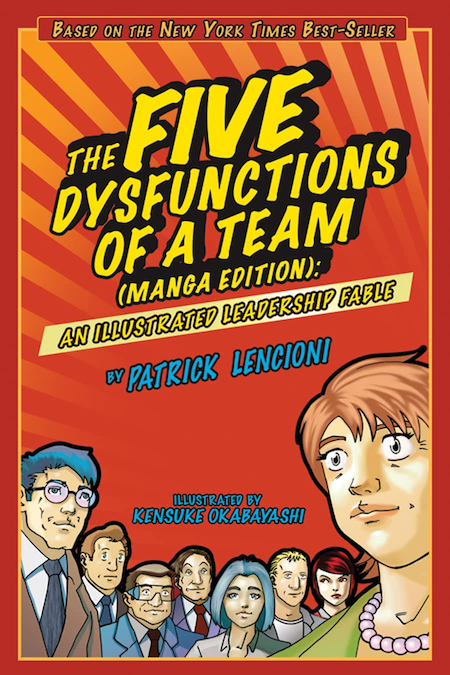- Tags:: 📚Books , ✒️SummarizedBooks , My management principles, values, and practices
- Author:: Patrick Lencioni, Kensuke Okabayashi
- Liked:: 6
- Link:: The Five Dysfunctions of a Team: An Illustrated Leadership Fable, Manga Edition | Wiley
- Source date:: 2008-10-31
- Finished date:: 2022-12-12
- Cover::

Why did I want to read it?
Good question… I don’t remember. I was probably looking for something else but found this manga version and definitely wanted to have it.
What did I get out of it?

The pyramid of dysfunction. Five reasons why teams go awry, where each reason can make it easier for the one above to also happen. From the base of the pyramid to the top:
- Absence of trust.
- Fear of conflict.
- Lack of commitment.
- Avoidance of accountability.
- Inattention to results.
With no trust, you avoid conflict. With no conflict, people won’t commit to a specific course of action. If there is no commitment, what standard would you use for accountability? And finally, with no accountability, you would be focused on personal goals, not on the company’s.
The interesting thing to realize is that most of those behaviors are human natural tendencies. So the objective is not to ignore this:
By acknowledging their human imperfections, great teams overcome the natural tendencies that make trust, conflict, commitment, accountability, and a focus on results so elusive. Ironically, great teams succeed because they are exceedingly human. (p. 173)
And as always, 🗞️ How to read self-help:
But this is a hallmark of wisdom: it’s trivial to read but nearly impossible to put into practice (…) we need lots of examples to drive this wisdom home. We should be more forgiving of self-help (the genre) and more forgiving of ourselves. Putting wisdom into practice takes requxires reading, reflection, and practice.
Link to original
… it’s common sense but:
Successful teamwork ultimately comes down to following a set of principles over a long period, and embracing common sense with uncommon levels of discipline, persistence and openness. (p. 173)
Absence of trust
In the context of team-building, trust means the team members know their team mates won’t use their vulnerabilities against them (p. 153)
In other words, Psychological safety as Google researchers find out in their famous Project Aristotle study (re:Work).
How to fix
Building this trust takes time and shared experiences (although the book shares dynamics to try to speed this up).
Specifically, as a leader:
To encourage trust, a leader must demostrate vulnerability (…) Risking a loss of face in front of the team encourages subordinates to do the same (p. 157).
So, lots of Brené Brown (📖 Daring Greatly ), and no machirulos (✍️ Sin machirulos hay paraiso. Una charla heterofriendly sobre management).
Fear of conflict
Charged (ideological) conflict is a normal part of work:
Personal attacks are out, but team members will still argue and get frustrated and emotional (p. 157)
It’s the path to working out the best solution in the shortest time (and also saves energy).
How to fix
- I particularly liked the proposal of having a “conflict miner” in a meeting:
Conflict miners brings buried disagreements to light, so they’ll need objectivity, the courage to get the team to work through sensitive issues, and the persistence to keep things moving until the conflict is resolved (p. 159).
- Remind each other in the middle of a discussion that we have permission to conflict.
- A tool for evaluating conflict: Thomas-Kilmann Conflict Mode Instrument .
Specifically, as a leader, stop overprotection:
Leaders need to allow the team to sort situations out themselves even when things get loud and messy (p. 161).
and of course, lead by example.
Lack of commitment
To have commitment, a team needs to make decisions with:
- Clarity
- Buy-in
The enemy of clarity is intolerance to Uncertainty, leading to Paralysis by analysis. The enemy of buy-in is obsessively seeking consensus. So, disagree and commit:
… reasonable people only want their opinions considered and don’t need to get their way to support a decision (p. 163)
This is something I’m not entirely sure I support, I’ve seen waaaay to many useless discussions (see ✍️ Refusing to stand on the shoulders of giants):
Teams that make decisions after lengthy discussions but little research or analysis find they make better-than-expected decision. Research and analysis are important, of course, but teams with this dysfunction tend to overrate their value (p. 165).
How to fix
- Having good meetings: review key decisions at the end to make sure everybody is on the same page.
- Deadlines.
- Contigency plans (see RFCs).
Avoidance of accountability
…Refers to the willingness of team members to call their peers on actions that might hurt the team (p. 166)
People usually do this in good faith, to avoid damaging friendships, but:
Ironically, that only damages ties when someone doesn’t live up to expectations (p. 167)
Peer pressure is the most effective way to maintain high performance standards (p. 167)
“No nos decimos lo suficiente lo buenos que somos”:
A team that avoids accountability encourages Mediocrity, especially when poor performers aren’t pressured to improve and the team leader is the sole source of discipline. (p. 167)
How to fix
- Publication of goals and standards.
- Progress reviews.
- Team rewards (away from individual rewards).
As a leader, encourage the team to monitor its accountability itself.
Inattention to results
Reminded me of somebody:

How to fix
- Again, publication of goals and standards.
- Results-based rewards.
And again, as a leader, lead by example (who would have thought?):
If the team senses that the leader values personal goals more, they’ll feel free to do the same (p. 173)